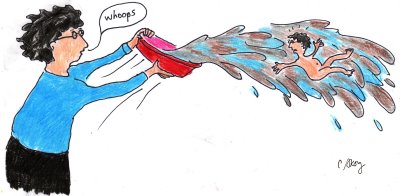The last blog post was all about slowing down, taking things easy, enjoying the unusually lovely weather, and yet here I am, only a few days later, reflecting on my default attitude to life which seems to be ‘Life is short, don’t hang around, make decisions, get things done, move on.’ 
I’m pretty sure I know why this is so: most of my immediate family members have died prematurely. Father went out to work one day when he was 45, died at work and never came home. Mother declined into Alzheimers in her mid-60s and died four years later. One of my older sisters died at 37 and another at 65. I think it was Dad’s sudden disappearance when I was nine that had the most profound effect. Suddenly my certainty about the future was fractured. If he could go without warning and with such effect, anything could happen, and the future could not be relied upon. If there was something I wanted to do, or to become, don’t wait. Just go for it. It may not be planned to perfection, but that’s OK.
Sometimes you need to ‘Ready, fire, aim’. If you think and dither around for too long it becomes ‘Ready, ready, ready.’
I was listening this morning to Michael Ondaatje,  author of ‘The English Patient’, talking about his writing approach which involves twenty edits before he commits to print. The first draft is just a sketch, and it goes from there. What patience, I thought to myself. How does he slow down enough to let such snail’s pace iteration happen? Could I ever work like that?
author of ‘The English Patient’, talking about his writing approach which involves twenty edits before he commits to print. The first draft is just a sketch, and it goes from there. What patience, I thought to myself. How does he slow down enough to let such snail’s pace iteration happen? Could I ever work like that?
Probably not! I’m 70 now, and enjoying every aspect of my life. I have many things to do and to learn, not just my writing. Worse, as soon as I start thinking about writing another book I start planning deadlines and put time pressure on myself. The urge to write too quickly is so strong that my first response now is to avoid that pressure altogether by not writing at all. There must be another way, surely, somewhere between Ondatjee’s caution and my usual recklessness.
The next step could be, consciously and deliberately, to dawdle. Just mess around for a while. I have some characters I’d like to play with, and I have a setting – it has to be Cumbria, nowhere else provides the same inspiration. Now what I need is a story, a real character-driven story, not just a series of twists and turns choreographed by some formulaic notion of ‘tension’. The story needs to intrigue me, and move me. The central character might be a police person but it’s not going to be a ‘police procedural’ or a forensic puzzle, both of which in the modern era require tedious technical research.
Maybe I should abandon even the pretence of ‘crime fiction’ and just tell a story about a person and a crisis. Above all, I need to drift and learn to use the first draft as a mere sketch. Only then will I know whether I’ve got something worth spending time on. ‘Ready, fire, aim.’

 (Considering my qualms about this method of book promotion, you might call it an ‘unhappy birthday to me’. ) Ever open-minded, I wanted to see what would happen in both the short-term and as a possible more lasting consequence.
(Considering my qualms about this method of book promotion, you might call it an ‘unhappy birthday to me’. ) Ever open-minded, I wanted to see what would happen in both the short-term and as a possible more lasting consequence.
 Having said that, something seems to depend on the reader. While some readers spot everything, and usually tell you so, others seem not to notice at all.
Having said that, something seems to depend on the reader. While some readers spot everything, and usually tell you so, others seem not to notice at all. It took a while. In my distress I managed to get highlighter on my duvet covet and it has proved impossible to get rid of, reminding me of the miserable business every time the duvet cover appears on my bed.
It took a while. In my distress I managed to get highlighter on my duvet covet and it has proved impossible to get rid of, reminding me of the miserable business every time the duvet cover appears on my bed. Almost at the end of the writing and editing process on the new book now, and the last thing on the list of issues to deal with is the opening paragraph. The current version has been written and rewritten countless times over the past few months and before I’m done it’ll be started all over again. Not many lines, maybe half a dozen sentences, but I want to get it as good as I can.
Almost at the end of the writing and editing process on the new book now, and the last thing on the list of issues to deal with is the opening paragraph. The current version has been written and rewritten countless times over the past few months and before I’m done it’ll be started all over again. Not many lines, maybe half a dozen sentences, but I want to get it as good as I can.
 opening details just a little more I’ll be up to the 85,000 word mark, exactly midway between the parameters suggested by expert colleague. Let’s hope so. I’m getting to the stage now when I never want to see this manuscript ever again.
opening details just a little more I’ll be up to the 85,000 word mark, exactly midway between the parameters suggested by expert colleague. Let’s hope so. I’m getting to the stage now when I never want to see this manuscript ever again.

 ntil it was dark I’d tapped away furiously, stopping only to gaze at the wall while I found a way through a barrier. The concentration was intense: it spilled over into those times when I wasn’t sitting at the laptop, and unfortunately haunted the night too. I would sleep for a couple of hours and then wake with dialogue or a plot twist in my head.The only way to break its hold on my mind was to play Solitaire on the ipad, which meant more screens, more eye strain and was probably not conducive to getting back to sleep. When I’m writing, the usual habit of reading before sleep doesn’t seem to work.
ntil it was dark I’d tapped away furiously, stopping only to gaze at the wall while I found a way through a barrier. The concentration was intense: it spilled over into those times when I wasn’t sitting at the laptop, and unfortunately haunted the night too. I would sleep for a couple of hours and then wake with dialogue or a plot twist in my head.The only way to break its hold on my mind was to play Solitaire on the ipad, which meant more screens, more eye strain and was probably not conducive to getting back to sleep. When I’m writing, the usual habit of reading before sleep doesn’t seem to work. I tell myself that the rewards are worth the painful gestation and birth. It’s undoubtedly true that you have to keep writing if you want to maintain people’s interest in your work and the sales that go with it. Every new books boosts sales of the previous ones. If you want press interest or access to speaking at book events and festivals you have to have a new book to showcase.
I tell myself that the rewards are worth the painful gestation and birth. It’s undoubtedly true that you have to keep writing if you want to maintain people’s interest in your work and the sales that go with it. Every new books boosts sales of the previous ones. If you want press interest or access to speaking at book events and festivals you have to have a new book to showcase. You will need an idea, a setting – time and place – some characters who interest you and a story that hopefully will engage potential readers. Whether you plan in detail or not is your choice, and you also decide when you will write, where, for how long, alone or in collaboration with others. Personally, I do plan – although the plan changes all the time. I write at home, out in the shed if the weather’s good, upstairs if it’s not too cold, and downstairs if I need more warmth. I research and plan for several months before starting the first draft and then I try to write chapters in the order in which they’ll be read. Once I’m writing, the first draft emerges pretty quickly.
You will need an idea, a setting – time and place – some characters who interest you and a story that hopefully will engage potential readers. Whether you plan in detail or not is your choice, and you also decide when you will write, where, for how long, alone or in collaboration with others. Personally, I do plan – although the plan changes all the time. I write at home, out in the shed if the weather’s good, upstairs if it’s not too cold, and downstairs if I need more warmth. I research and plan for several months before starting the first draft and then I try to write chapters in the order in which they’ll be read. Once I’m writing, the first draft emerges pretty quickly. This is where the details of the story are checked to see if they hang together. Does the chronology work? Are there inconsistencies of any kind? Does every chapter/scene add to the story? Does the plot develop in a way that keeps the reader going? I like to get feedback from someone who’s not encountered the story before, beyond the initial outline. The person needs to understand how stories work, to be clear in their judgement and able to provide a critique which is helpful without being bossy – it’s your story, after all.
This is where the details of the story are checked to see if they hang together. Does the chronology work? Are there inconsistencies of any kind? Does every chapter/scene add to the story? Does the plot develop in a way that keeps the reader going? I like to get feedback from someone who’s not encountered the story before, beyond the initial outline. The person needs to understand how stories work, to be clear in their judgement and able to provide a critique which is helpful without being bossy – it’s your story, after all. One of my books slipped through this stage with insufficient attention and I have regretted it ever since – far too many tiny errors that a fast reader wouldn’t even notice but a slow/picky reader did and will. There’s always a kind person out there who will send you the unbearable list of mistakes. The best way to get the proofs properly checked is to have them read by someone with a professional and very picky approach and who has never encountered your story before, at all, ever. Some of the best proof-readers read from back page to front to avoid getting so involved with the story that their reading speed picks up and mistakes are missed. We need proof-readers, even if we might not want to spend the evening with them.
One of my books slipped through this stage with insufficient attention and I have regretted it ever since – far too many tiny errors that a fast reader wouldn’t even notice but a slow/picky reader did and will. There’s always a kind person out there who will send you the unbearable list of mistakes. The best way to get the proofs properly checked is to have them read by someone with a professional and very picky approach and who has never encountered your story before, at all, ever. Some of the best proof-readers read from back page to front to avoid getting so involved with the story that their reading speed picks up and mistakes are missed. We need proof-readers, even if we might not want to spend the evening with them. ayed at home.
ayed at home.